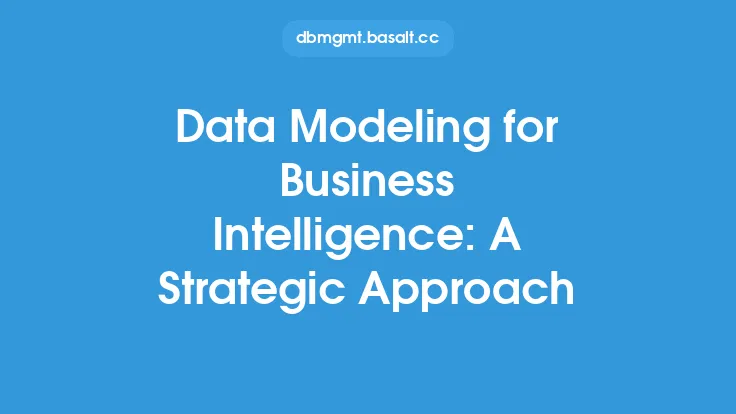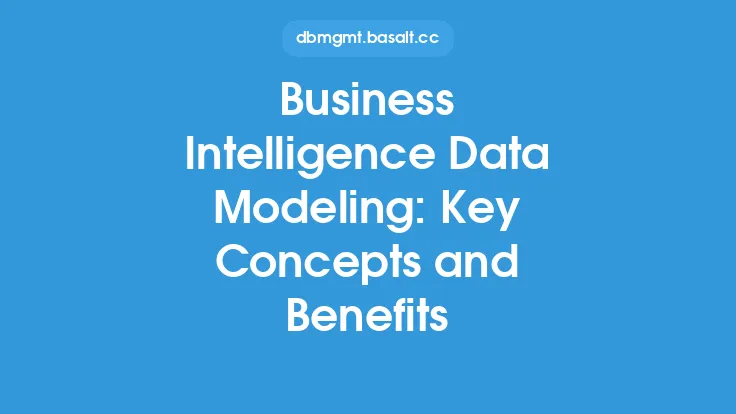Data modeling is a crucial aspect of business intelligence and data analysis, as it enables organizations to make informed decisions by providing a clear and concise representation of their data. At its core, data modeling involves creating a conceptual representation of an organization's data, which can be used to support business intelligence and data analysis activities. This involves identifying the key entities, attributes, and relationships that exist within an organization's data, and representing them in a way that is easy to understand and analyze.
Introduction to Data Modeling Techniques
There are several data modeling techniques that can be used to support business intelligence and data analysis, including entity-relationship modeling, dimensional modeling, and object-oriented modeling. Entity-relationship modeling is a traditional approach to data modeling that involves identifying the key entities, attributes, and relationships that exist within an organization's data. This approach is often used to create a conceptual representation of an organization's data, which can be used to support business intelligence and data analysis activities. Dimensional modeling, on the other hand, is a technique that is specifically designed to support data warehousing and business intelligence activities. This approach involves creating a data model that is optimized for querying and analysis, and is often used to create data warehouses and data marts.
Entity-Relationship Modeling
Entity-relationship modeling is a fundamental technique that is used to create a conceptual representation of an organization's data. This approach involves identifying the key entities, attributes, and relationships that exist within an organization's data, and representing them in a way that is easy to understand and analyze. Entities are the key objects or concepts that exist within an organization's data, such as customers, products, and orders. Attributes are the characteristics or properties of these entities, such as customer name, product description, and order date. Relationships are the connections that exist between these entities, such as the relationship between a customer and an order. Entity-relationship modeling involves creating a diagram that shows the relationships between these entities, which can be used to support business intelligence and data analysis activities.
Dimensional Modeling
Dimensional modeling is a technique that is specifically designed to support data warehousing and business intelligence activities. This approach involves creating a data model that is optimized for querying and analysis, and is often used to create data warehouses and data marts. A dimensional model consists of a fact table and one or more dimension tables. The fact table contains the measures or metrics that are being analyzed, such as sales amounts or customer counts. The dimension tables contain the attributes or characteristics of these measures, such as date, product, or customer. Dimensional modeling involves creating a star or snowflake schema, which is a diagram that shows the relationships between the fact table and the dimension tables.
Object-Oriented Modeling
Object-oriented modeling is a technique that is used to create a conceptual representation of an organization's data, using object-oriented principles. This approach involves identifying the key objects or concepts that exist within an organization's data, and representing them as classes or objects. Each class or object has its own attributes and methods, which are used to define its characteristics and behavior. Object-oriented modeling involves creating a class diagram, which shows the relationships between the classes or objects. This approach is often used to create a conceptual representation of an organization's data, which can be used to support business intelligence and data analysis activities.
Data Modeling for Data Warehousing
Data modeling is a critical aspect of data warehousing, as it enables organizations to create a data warehouse that is optimized for querying and analysis. A data warehouse is a centralized repository that stores data from multiple sources, and is used to support business intelligence and data analysis activities. Data modeling for data warehousing involves creating a data model that is optimized for querying and analysis, and is often used to create a data warehouse or data mart. This approach involves identifying the key entities, attributes, and relationships that exist within an organization's data, and representing them in a way that is easy to understand and analyze.
Data Modeling Tools and Technologies
There are several data modeling tools and technologies that can be used to support business intelligence and data analysis activities. These tools and technologies include data modeling software, such as Entity-Relationship Diagram (ERD) tools, and data warehousing platforms, such as Amazon Redshift or Google BigQuery. Data modeling software is used to create a conceptual representation of an organization's data, and can be used to support entity-relationship modeling, dimensional modeling, and object-oriented modeling. Data warehousing platforms, on the other hand, are used to create a data warehouse or data mart, and can be used to support data modeling, data integration, and data analysis activities.
Best Practices for Data Modeling
There are several best practices that can be used to ensure that data modeling activities are successful. These best practices include involving stakeholders in the data modeling process, using a standardized data modeling approach, and ensuring that the data model is aligned with business requirements. Involving stakeholders in the data modeling process ensures that the data model is relevant and useful to the organization, and that it meets the needs of business users. Using a standardized data modeling approach ensures that the data model is consistent and easy to understand, and that it can be used to support multiple business intelligence and data analysis activities. Ensuring that the data model is aligned with business requirements ensures that the data model is relevant and useful to the organization, and that it supports business decision-making activities.
Common Data Modeling Mistakes
There are several common data modeling mistakes that can be made, which can have a negative impact on business intelligence and data analysis activities. These mistakes include failing to involve stakeholders in the data modeling process, using a data modeling approach that is not standardized, and failing to ensure that the data model is aligned with business requirements. Failing to involve stakeholders in the data modeling process can result in a data model that is not relevant or useful to the organization, and that does not meet the needs of business users. Using a data modeling approach that is not standardized can result in a data model that is inconsistent and difficult to understand, and that cannot be used to support multiple business intelligence and data analysis activities. Failing to ensure that the data model is aligned with business requirements can result in a data model that is not relevant or useful to the organization, and that does not support business decision-making activities.
Conclusion
Data modeling is a critical aspect of business intelligence and data analysis, as it enables organizations to make informed decisions by providing a clear and concise representation of their data. There are several data modeling techniques that can be used to support business intelligence and data analysis activities, including entity-relationship modeling, dimensional modeling, and object-oriented modeling. By using these techniques, and by following best practices for data modeling, organizations can create a data model that is optimized for querying and analysis, and that supports business decision-making activities. Additionally, by avoiding common data modeling mistakes, organizations can ensure that their data model is relevant, useful, and aligned with business requirements.





